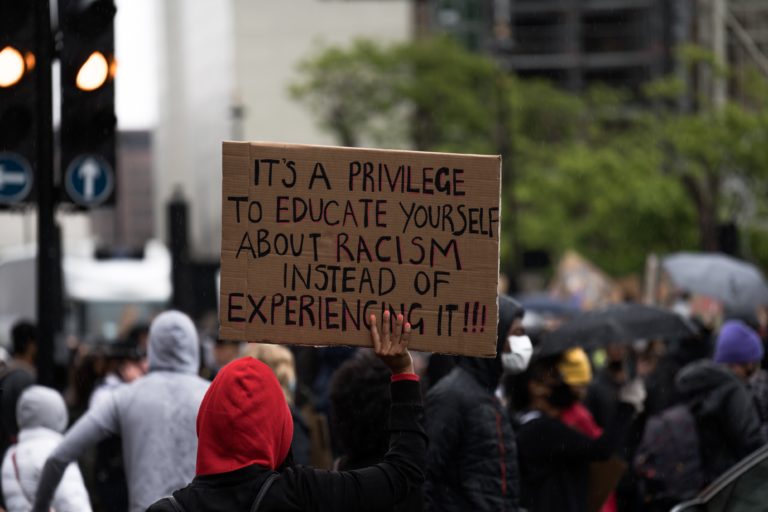There were mostly middle-aged white people, residents of the city in which I live, congregating on the front lawn of city hall when I arrived that night. A state assemblyman from my district was speaking on a bullhorn, urging people to stay until 7pm, when the curfew would begin. At 6pm, a line of military trucks from all over the state came cruising down the avenue before stopping at the light, flexing their military muscle to the people lining the sidewalk. Residents shouted, “Go home” and “We don’t want you here.”
We moved to this community nearly 30 years ago because we wanted to live in a diverse community. One that offered good schools filled with Black and brown kids, so very different from our own experience of growing up in an almost exclusively white suburb across town. The world we’d be sending our kids into would be a more diverse one, and we wanted to prepare them for an experience that would be more colorful than our own.
A group of young people, mostly Black, joined us on the front lawn just before 7. They began chanting, led by young men using a bull horn, sing-song like, calling back-and-forth, reminding me of the evangelical church in Savannah I attended one Easter. But instead of gospel hymns, they chanted, “Why you dressed in riot gear? I don’t see no riot here” and “Black lives matter.” They also chanted, “Say his name. Alvin Cole,” referencing the young man who’d been gunned down nine months ago by a local police officer. It was the officer’s third shooting in five years. All three victims died.
At 7pm, the crowd began to thin a bit; some of the white residents left while the young, Black group remained strong, holding signs over their heads and chanting, always chanting. Military trucks pulled up again, only this time, they parked, lights flashing. As it grew closer to 7:30pm, a line of military police, dressed head-to-toe in camouflage and riot gear—helmets, face protectors, body shields—formed a line and began advancing on the crowd. People leading the protest stood their ground and kept on chanting, competing with a police bullhorn informing us that we were out past curfew, that we were a part of an unlawful assembly, that we needed to disperse.
My kids received a great education in this community. And both had friends of different races and ethnicities. Our neighbors have been Black, brown, gay. We congratulated ourselves for living in such a diverse city. But through the years, we also saw too many people of color pulled over on our streets, even though my husband drove illegally with a single license plate for more than a dozen years and was never stopped. One time, my son witnessed his Black friend’s father, a pastor, pulled over almost immediately after leaving the high school parking lot after a wrestling meet, while the rest of us—all white—left without officers even glancing in our direction. Another time, I attended a meeting where a proposed development near my neighborhood required adding a bus line. “We don’t want buses bringing those people into our neighborhoods,” someone said. Another person lamented that the proposed apartment complex might attract “people who aren’t a part of our way of life.”
Just before 8pm, we received a text from a friend who lives a block south from the protest. “There are trucks parked on my street and they’re putting on gas masks,” she wrote. Would they really use tear gas on us? For a curfew violation? The chanting turned into singing: “Are you ready? Are you ready? Are you ready, for a change?” They sang it over and over again, their passion and anger growing as the line of military police grew closer. One young woman, beautiful and Black, approached the line of advancing officers, dancing and singing before she returned to where we stood. Still, the police advanced. We turned to leave, heading west, but another, similar line of military trucks and police in riot gear was positioned on the adjacent street, blocking our path and advancing toward us. And we couldn’t head north, as lights of police cars flashed in the distance. So we turned in the only direction available to us: east. Helicopters and drones whirred overhead.
“Leave now,” said a young Black man as we approached. So we did. And as we passed some National Guards, one said to us, “Good evening.” Not “You’re out past curfew.” Not, “You’re part of an unlawful assembly.” Not any of the things we’d been hearing over a bullhorn for nearly an hour. Just “Good evening.” As we walked home, four middle-aged white people carrying protest signs, we looked back. Clouds of tear gas hung over the remaining group of mostly young, mostly Black protesters, penned in at the intersection in front of city hall.
They were still chanting.
Photo by James Eades on Unsplash


1 Comment
Powerful. Speaking for many of us middle-aged and up white people who care.